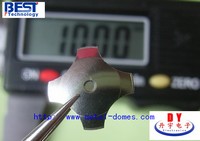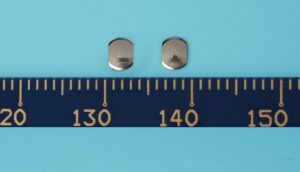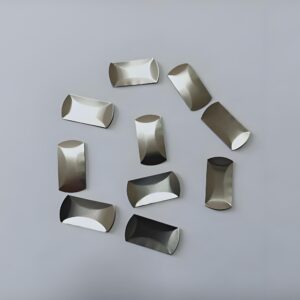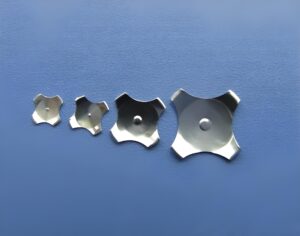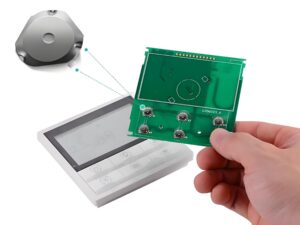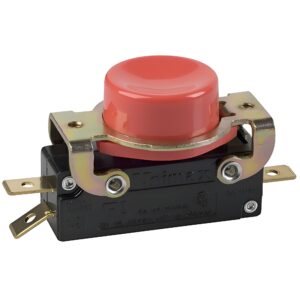Rubber button, as the name implies, are buttons made of rubber materials. They have a certain degree of elasticity and flexibility. The shape and size of the button body can be designed and customized according to different application requirements. Common ones are round, square, rectangular, etc. When the button is pressed, the conductive part will contact other components in the circuit to realize the transmission of electrical signals.
What are rubber buttons?
Rubber buttons are a type of button commonly used in electronic products. Their outer layer is usually made of rubber material, which has the characteristics of softness, non-slip and wear resistance.
The working principle of rubber buttons is to realize the circuit path through the internal metal contact contact, similar to ordinary mechanical switches, but it does not require mechanical force to achieve the pressing, but a slight press to achieve “touch-type pressing”.
Rubber buttons are widely used in various switches, buttons, handles and other products, such as remote controls, keyboards, etc. Due to its excellent elasticity and touch, it is more comfortable to use;
At the same time, the high temperature resistance and aging resistance of silicone materials make it have a long service life. In addition, the anti-slip and safety of rubber buttons also make them perform well in various usage scenarios.
How do rubber buttons work?
Rubber buttons usually consist of three parts: an upper button, a lower button, and a metal dome. The upper button is usually made of hard materials such as PC or silicone, while the lower button is made of soft rubber.
The function of the metal dome is to produce elastic deformation when the upper button is pressed, so that the button is reset. When the button is pressed, the internal metal contacts come into contact, forming a circuit path, thereby realizing the control of electronic products.
The material of rubber buttons is usually silicone or natural rubber. Silicone has better high temperature resistance and anti-aging performance, and is more durable; natural rubber has better elasticity and comfort.
Hardness is an important factor in selecting rubber buttons. Too high hardness will lead to a bad feel, and too low hardness will make the button too soft, affecting use. In addition, the surface treatment methods of rubber buttons such as spraying, silk screen printing, etc. can also be selected according to actual needs.
How do tactile buttons work?
- Mechanical tactile buttons: There are keycaps, domes, and contacts inside. When the keycap is pressed, the spring deforms and contacts the contact point to conduct the circuit. The elastic recovery of the spring and the interaction of the shell generate tactile feedback, allowing the user to feel the button being pressed and rebounded.
- Capacitive tactile button: works based on capacitance changes. When the finger approaches or touches the button, the capacitance value changes, and the internal circuit detects the change and triggers the corresponding operation. Its tactile feedback is achieved through the built-in linear vibration motor to simulate real touch.
- Pressure-sensitive tactile button: based on the pressure sensor to sense pressure, the operation is triggered when the pressure reaches the set threshold. The tactile feedback of this button can be associated with pressure. For example, the greater the pressure, the stronger the vibration intensity of the feedback, which is convenient for users to operate accurately.
What rubber is used for buttons?
1. Natural rubber
Natural rubber has good elasticity and flexibility. It can quickly return to its original state after being pressed, providing a comfortable touch. It has good tensile strength and wear resistance, good fatigue resistance, and is not easily damaged by multiple presses.
Commonly used for buttons of consumer electronic products that have high requirements for touch and are not used very frequently, such as buttons of simple electronic toys.
2. Silicone rubber
Silicone rubber has excellent high and low temperature resistance, can work normally in the temperature range of -50? to 200?, has good electrical insulation, high chemical stability, and soft and smooth touch.
It is used for equipment buttons working in extreme temperature environments, such as outdoor electronic equipment, aerospace equipment buttons, and also for some high-end electronic product buttons.
What are the advantages of rubber buttons?
The advantages of rubber buttons mainly include the following aspects:
Durability and wear resistance: Rubber buttons have high wear resistance and durability, can withstand frequent use and pressure, are not easy to wear, and are suitable for use in environments that require high durability.
Anti-slip: The surface of rubber buttons is relatively smooth. Although the anti-slip property is poor, this property can be improved by adding an anti-slip surface.
Comfortable feel: Rubber buttons have a harder feel, but compared to plastic buttons, they feel more comfortable and are suitable for application scenarios that require frequent operations.
Cost-effectiveness: The manufacturing cost of rubber buttons is relatively low, which is suitable for occasions where cost control is required.
The disadvantages of rubber buttons include:
Poor anti-slip performance: The surface of rubber buttons is relatively smooth and has poor anti-slip performance, which may affect the user experience.
Hard feel: Compared with silicone buttons, rubber buttons have a harder feel and are less comfortable.
What is the difference between rubber and silicone rubber?
The main differences between rubber and silicone rubber are definition, composition and use.
Different definition range: Rubber is a general term that includes many types, such as natural rubber, styrene-butadiene rubber, etc., and silicone rubber is also one of them. Silicone is a specific variety of rubber, and its main component is silicon dioxide.
Different composition: The main component of rubber is rubber hydrocarbon, while the main component of silicone is silicon dioxide.
Different uses: Rubber is mainly used in industry, such as tires, hoses, rubber rollers, etc. Silicone is mainly used in food, household electrical appliances and other fields, such as electric pressure cooker seals, etc.
Different properties: Silicone has the characteristics of good adsorption, insoluble in water, and not easy to burn. Rubber is a highly elastic polymer compound with high elasticity and wear resistance, but easy to burn.
Price and performance: Silicone rubber is more expensive and has superior performance, and is suitable for occasions with high performance requirements. Ordinary rubber products are usually more economical if they can meet the needs.
Which is tougher silicone or rubber?
“Silicone” is a type of rubber, and the commonly referred to “rubber” refers to traditional rubber materials such as natural rubber or styrene-butadiene rubber. They have the following differences in toughness from silicone:
1. Tensile strength
Traditional rubber: Natural rubber has a higher tensile strength. For example, without adding a reinforcing agent, the tensile strength of natural rubber can reach about 17-29MPa.
Silicone: The tensile strength of silicone is generally relatively low. The tensile strength of pure silicone may be between 4-10MPa. However, by adding a suitable reinforcing agent, its tensile strength can be significantly improved.
2. Wear resistance
Traditional rubber: Take natural rubber as an example, it has good wear resistance. During the friction with other surfaces, natural rubber can disperse the friction through its own elastic deformation, and it can recover well after friction.
Silicone: Silicone is generally not as wear-resistant as traditional rubber. This is because the surface of silicone is relatively soft and is more easily worn during friction.
In summary, in general, traditional rubber is tougher than silicone in some aspects of toughness (such as tensile strength, tear resistance and wear resistance).
In short, rubber buttons have the advantages of good elasticity and flexibility, excellent wear resistance and corrosion resistance, good insulation performance, easy processing and customization, and low cost. They are widely used in electronic equipment, household appliances, industrial control, medical equipment and other fields.







